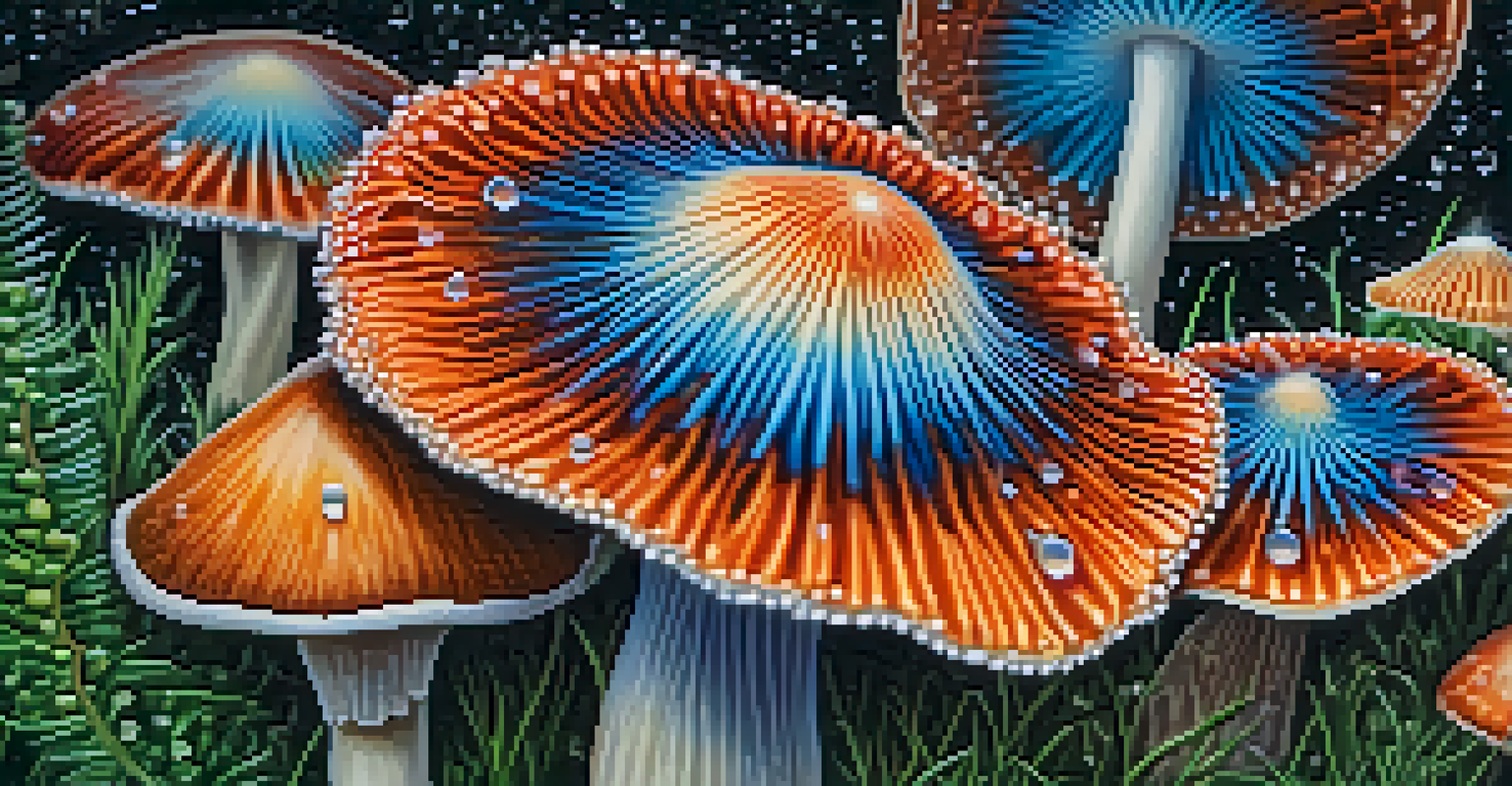Entheogens and Consciousness: A Comparative Analysis

Understanding Entheogens: Definition and Context
Entheogens are substances that are often used in spiritual contexts to enhance consciousness. They include a wide range of natural and synthetic compounds, such as psilocybin mushrooms, ayahuasca, and LSD. Traditionally, these substances have been utilized in various cultures for healing, divination, and religious ceremonies, aiming to connect the user with a higher state of awareness.
Entheogens can be seen as catalysts for personal and collective transformation.
The term 'entheogen' itself is derived from the Greek words 'entheos' meaning 'full of the divine' and 'genes' meaning 'to generate.' This etymology underscores the primary purpose of these substances—to facilitate profound spiritual experiences. Understanding their historical context helps frame the modern interest in their potential benefits.
In recent years, there has been a resurgence in research exploring the therapeutic potential of entheogens, particularly in treating conditions like depression and PTSD. This renewed interest invites a deeper examination of how these substances affect human consciousness and our perception of reality.
The Science Behind Entheogens: How They Work
Entheogens primarily interact with the brain's serotonin receptors, particularly the 5-HT2A receptor. This interaction alters neural pathways, leading to changes in mood, perception, and thought processes. As a result, users often report experiences that feel transcendent or enlightening, offering a unique lens through which to view their lives and the world around them.

For example, studies have shown that psilocybin can induce profound emotional insights and a sense of interconnectedness. This can lead to lasting changes in perspective, reinforcing the idea that our consciousness is not static but rather a dynamic interplay of experiences and perceptions. Understanding the neurobiology behind these experiences helps demystify the effects of entheogens.
Entheogens Enhance Spiritual Awareness
Entheogens are substances used to facilitate spiritual experiences and enhance consciousness, often leading to profound personal insights.
Moreover, the subjective nature of these experiences can vary widely from person to person. Some may encounter feelings of bliss, while others confront deeply buried emotions. This variability highlights the importance of set and setting, or the mindset of the user and the environment in which the substance is consumed.
Historical Use of Entheogens in Indigenous Cultures
Throughout history, many indigenous cultures have embraced the use of entheogens as sacred tools for spiritual connection and healing. For instance, the use of peyote in Native American rituals is a profound example of how these substances can facilitate spiritual journeys and communal bonding. These practices often emphasize respect and reverence for the natural world.
Psychedelics can help people see their problems in a new light, allowing for breakthroughs in mental health treatment.
In South America, the Amazonian brew ayahuasca has been used for centuries by various tribes, serving as a means to communicate with spirits and gain insight into personal and communal issues. These traditional practices highlight the deep-rooted belief in the transformative power of entheogens, shaping their cultures and worldviews.
Such historical contexts provide valuable insights into the ethical considerations regarding the modern, often recreational use of these substances. Understanding their origins encourages a more respectful approach to entheogens, acknowledging their role as sacred elements in cultural practices rather than mere substances for escapism.
Contemporary Research: Entheogens and Mental Health
In recent years, scientists have begun to explore the therapeutic potential of entheogens in treating mental health disorders. Research has indicated that substances like psilocybin and MDMA can help alleviate symptoms of depression, anxiety, and PTSD by promoting emotional breakthroughs and facilitating new perspectives.
For instance, a study conducted by Johns Hopkins University found that participants who received psilocybin therapy reported significant reductions in anxiety and depression, lasting for months after treatment. These findings suggest that entheogens may provide a valuable alternative for individuals who have not responded to traditional therapies.
Therapeutic Potential for Mental Health
Recent research suggests that entheogens like psilocybin may effectively alleviate symptoms of mental health disorders such as depression and PTSD.
However, while the results are promising, it is crucial to approach this research with caution. Mental health treatment should always be conducted in a controlled, supportive environment, emphasizing safety and integration of the experiences into the individual's life.
Entheogens and Spiritual Awakening: A Personal Journey
Many users of entheogens describe their experiences as spiritual awakenings that profoundly transform their understanding of self and existence. These journeys can lead to a sense of unity with the universe, offering insights that challenge conventional beliefs about identity and purpose.
For example, someone might find that their typical worries about daily life fade away during an entheogenic experience, replaced by a sense of peace and interconnectedness with all living beings. This shift in perspective can foster greater compassion, empathy, and a desire for personal growth.
However, it's essential to recognize that these experiences can be deeply personal and not universally applicable. What one person considers a spiritual revelation may differ vastly from another's experience. This individuality underscores the complexity of consciousness and the subjective nature of spiritual exploration.
Risks and Considerations: The Dark Side of Entheogens
While entheogens can offer transformative experiences, they are not without risks. Some individuals may experience challenging or negative reactions, often referred to as 'bad trips.' These can lead to feelings of anxiety, paranoia, and confusion, highlighting the importance of preparation and support.
Additionally, the legal status of many entheogens complicates their use. In many countries, substances like psilocybin and ayahuasca are still classified as illegal, creating barriers to access and research. This legal landscape often perpetuates stigma and misunderstandings about their potential benefits.
Risks and Ethical Considerations
While offering transformative experiences, entheogens carry risks and ethical concerns, highlighting the need for responsible use and respect for their cultural origins.
Therefore, anyone considering exploring entheogens should approach them with caution, ideally under the guidance of professionals or experienced practitioners. Education about safe practices and the potential psychological impacts is crucial for minimizing risks.
The Future of Entheogens: Trends and Possibilities
As interest in the therapeutic potential of entheogens grows, we may be on the brink of a paradigm shift in mental health care. With ongoing research and increasing decriminalization efforts, these substances could become integral components of holistic treatment approaches.
Moreover, as society begins to embrace the spiritual dimensions of entheogens, there could be a resurgence in traditional practices and rituals. This revival would not only honor the cultures that have long utilized these substances but also provide a more profound understanding of their potential.

Ultimately, the future of entheogens is intertwined with our evolving perceptions of consciousness, spirituality, and mental health. As we continue to explore these dimensions, we may uncover new pathways for healing and personal transformation.